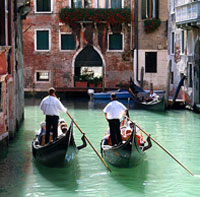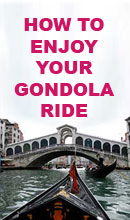How to Enjoy Your Gondola Ride
No Tour of Venice Would Be Complete Without Gondola Ride!
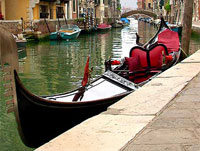 Gondola is a symbol of Venice just as Rialto Bridge, the winged lion or San Marco Square are. Venice’s gondola is a legend, a unique work of art. Everything is thought-out and symbolic in gondola. To create a real Venetian gondola one needs to turn 289 details from 8 sorts of timber. Gondola is asymmetric: its front side is always higher than the back side to compensate the weight of the rower. His place and the rowlock are always put behind the passengers. On gondola’s bow the weight of the gondolier is balanced by a 30kg iron standard called ferro in Italian.
Gondola is a symbol of Venice just as Rialto Bridge, the winged lion or San Marco Square are. Venice’s gondola is a legend, a unique work of art. Everything is thought-out and symbolic in gondola. To create a real Venetian gondola one needs to turn 289 details from 8 sorts of timber. Gondola is asymmetric: its front side is always higher than the back side to compensate the weight of the rower. His place and the rowlock are always put behind the passengers. On gondola’s bow the weight of the gondolier is balanced by a 30kg iron standard called ferro in Italian.
To fully enjoy your Gondola Ride follow these simple steps:
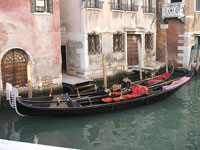 Step 1 - Know the History
Step 1 - Know the History
Although there are over 40 types of traditional boats native to Venice, it is the gondola that is most easily recognizable. It is the most elegant means of water transportation, named for the first time in 1094 by Doge Vitale Falier.
The gondola has gone through many modifications over the centuries, both in form and the finer details. The modern gondola has very specific measurements and specifications. The outer length is 10.85 meters, with an average width of 1.40 meters and a net weight of about 350 kilograms. Made up of around 280 wooden pieces, the gondola uses a variety of wood in its construction, including oak, fir, walnut, cherry-wood, larch, elm-root, and limetree. Despite modern techniques, the wood used for the sides of the gondola is curved using an ancient process that involves using marsh canes – which come from nearby lagoons – to heat the wood until it can be curved. These marsh canes are said to have the degree of humidity required for the operation. This process gives the gondola amazing balance, although it appears likely to topple over at any moment.
Gondolas were used for transport in the reign of the first doge in the 7th century A.D. Only then they were more luxurious and brighter. Venetian gondolas became black only in 1562 when during the plague corpses were brought about the city in gondolas. Smartness of gondolas looked absurdly and the government issued an edict to color gondolas black like coffins. The sorrowful events of Middle Ages changed the city’s face forever.
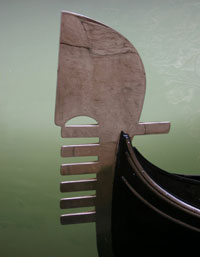 Step 2 - Know the Symbolics of Gondola's Form
Step 2 - Know the Symbolics of Gondola's Form
The gondola is special, not only because of its unique shape, but also because of “el parecio”: its ornamentation. The most important of this ornamentation is the ferro.
The ferro is the distinctive metal design at the prow, or front, of the gondola. It has gone through over 1,000 modifications since its creation; its curled design is not only for aesthetic reasons but also to defend it from possible damage through collisions. It was once made from soft iron, but modern ferros are made with duralumin or other alloys; depending on the metal used, the ferro’s weight can vary from 10 to 20 kilograms. The unique shape of the ferro is famous worldwide – popular tradition maintains that the six teeth represent the six districts of Venice; the elegant curve signifies the Doge’s cap, or the Grand Canal. The semi-circular break between the curved 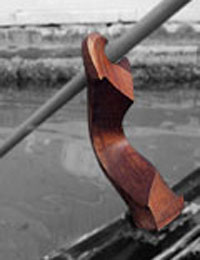 top and the six teeth is said to represent the Rialto Bridge. The ferro has become a symbol of the gondola, which is, in turn, a symbol of Venice itself. (back to top)
top and the six teeth is said to represent the Rialto Bridge. The ferro has become a symbol of the gondola, which is, in turn, a symbol of Venice itself. (back to top)
Step 3 - Know How It Moves
The remo (oar) and forcola (oarlock) are two of the most practically important parts of the gondola. The forcola, carefully shaped with a large bend for maximum strength, is made from a single piece of walnut root. It is placed at the stern of the gondola, where it is the true point of strength, which allows the boat to lean and lower on the right-hand side. It’s main function is to give support to the oar, as the gondolier pushes on the oar to propel the gondola forward.
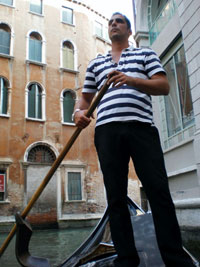 Step 4 - Know the Uniform of the Gondolier
Step 4 - Know the Uniform of the Gondolier
It is hard to discuss the gondola without mentioning the gondolier. These people have as long and rich a history as the boat itself. In the late 1500s, when personal luxury in the gondola was forbidden, the gondoliers’ uniforms were required to be simple and sober. It was for this reason that they wore simple black up until World War II, when the influence of the French Army altered the uniforms. Today, gondoliers can be seen wearing blue and white or red and white striped shirts, a sight that has become a familiar part of Venetian culture. (back to top)
Step 5 - Choose Your Ride Wisely
Why to take a gondola ride?
Technically the gondola is a mode of transportation, and technically you might find a gondolier willing to ferry you from point A to point B, but in practice these most famous of Venetian boats operate as supremely overpriced tourist mini-cruises, not as a viable means of public transportation.
Why to take the Private Tour: Venice Gondola with Serenade?
Click here to see what it's all about
Here are the opinions of their customers:
The singer and guitar player transformed this gondola ride into something idyllic. Doing a private ride with music is a little pricey but I wouldn't do it any other way. It was DEFINITELY worth the price of admission!
This way exceeded our expectations. The gondola was ready 10 minutes early and the accordionist and serenader sat in the front. The music and singing was beautiful and attracted quite a crown of admirers as we passed under bridges and alongside walk ways. We felt special and enjoyed every moment. We booked at 8pm, which in early May is just before sunset which is an ideal time to go. One risks inclement weather but we were lucky to have sunshine and blue skies.
The company in Venice is excellent. There are certainly many options, but this was the only gondola with Serenade that we saw all day. The music was excellent and made the ride very special. It was the highlight of our trip and worth the extra money. We found the meeting spot easily. And I was pleased with the quality of the service.
How much does a gondola ride cost?
The official rates if you're using a gondola as a taxi are €80 ($104) for up to 6 people for a 40-minute ride; additional 20 minute increments cost €40 ($52). As soon as the clock strikes 7pm, the price jacks up to €100 ($130) for 40 minutes, €50 ($65) each additional 20 minutes.
How long does a gondola ride last?
The average gondola ride lasts 40 minutes. Make absolutely sure you agree upon the price and the duration of the trip before you step into the boat, write it down, and go by your watch (strangely, the gondoliers' often run fast).
Don't confuse a traghetto with a gondola
 Want a rowboat ride in Venice without forking over more than $100? Head down any street named Calle del Traghetto leading toward the Grand Canal (marked by a yellow sign with the black gondola symbol) and hop aboard a traghetto (ferry skiff).
Want a rowboat ride in Venice without forking over more than $100? Head down any street named Calle del Traghetto leading toward the Grand Canal (marked by a yellow sign with the black gondola symbol) and hop aboard a traghetto (ferry skiff).
These oversized gondolas rowed by two gondolieri cross the Grand Canal at eight intermediate points not covered by the Grand Canal's four bridges. The fare is a bargain €0.50 (60¢), which you hand to the gondolier when boarding. You then ride standing up. It only lasts five or six minutes, but it's a thoroughly Venetian way of getting around—and way cheaper than a tourist gondola.
Be a gondolier for the day—Gondola rowing lessons
Ever wanted to take the stick and learn how to steer a gondola around the canals of Venice? Several tour services teach you do just that: spend the afternoon taking gondola driving lessons.
The easiest to use is Row Venice (tel. +39-345-241-5266, www.rowvenice.com), which will teach you the Voga Veneta, the traditional Venetian rowing style, in an open, canoe-like boat called a sandolo (think of it as the gondola's less stylish cousin). Lessons last two hours and cost €50 (or €40 per person for two).
If only a full-fledged gondola will do, ArtViva tours (tel. +39-055-264-5033; www.italy.artviva.com) offers a two-hour "Learn to be a Gondolier" tour for €80 (min. 1 person, max. 4; tours at 9am, 11am, 2pm, and 4pm Mon–Sat). (back to top)
- Gondola rides last 40 minutes, unless you pay for overtime.
- Make absolutely sure you agree upon the price and the duration of the trip before you step into the boat.
- You can get a cheaper ride by sharing the boat with other tourists.
- Evening rides are more romantic, but cost a premium. If you want a cheaper ride you have to take it before 7pm.
- All gondoliers will want to row you in a big circle back to where you boarded. If you want to end up elsewhere, insist upon it—firmly but politely.
Step 6 - Remember these Tips to Avoid Dissapointment
